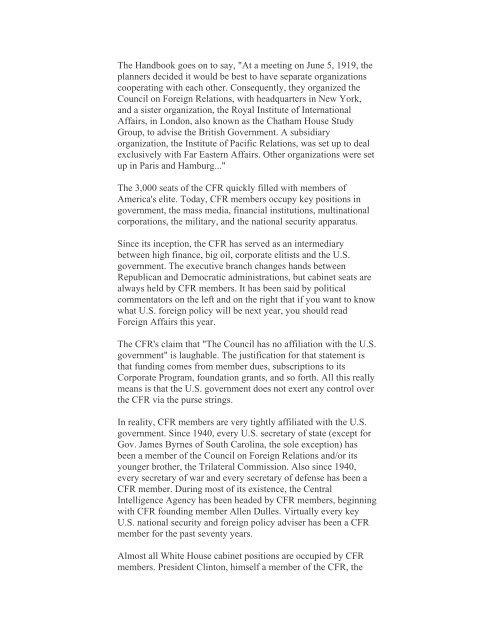70-years-chart-illustrates-the-dominance-by-the-cfr-trilaterals-bilderbergers
70-years-chart-illustrates-the-dominance-by-the-cfr-trilaterals-bilderbergers
70-years-chart-illustrates-the-dominance-by-the-cfr-trilaterals-bilderbergers
You also want an ePaper? Increase the reach of your titles
YUMPU automatically turns print PDFs into web optimized ePapers that Google loves.
The Handbook goes on to say, "At a meeting on June 5, 1919, <strong>the</strong><br />
planners decided it would be best to have separate organizations<br />
cooperating with each o<strong>the</strong>r. Consequently, <strong>the</strong>y organized <strong>the</strong><br />
Council on Foreign Relations, with headquarters in New York,<br />
and a sister organization, <strong>the</strong> Royal Institute of International<br />
Affairs, in London, also known as <strong>the</strong> Chatham House Study<br />
Group, to advise <strong>the</strong> British Government. A subsidiary<br />
organization, <strong>the</strong> Institute of Pacific Relations, was set up to deal<br />
exclusively with Far Eastern Affairs. O<strong>the</strong>r organizations were set<br />
up in Paris and Hamburg..."<br />
The 3,000 seats of <strong>the</strong> CFR quickly filled with members of<br />
America's elite. Today, CFR members occupy key positions in<br />
government, <strong>the</strong> mass media, financial institutions, multinational<br />
corporations, <strong>the</strong> military, and <strong>the</strong> national security apparatus.<br />
Since its inception, <strong>the</strong> CFR has served as an intermediary<br />
between high finance, big oil, corporate elitists and <strong>the</strong> U.S.<br />
government. The executive branch changes hands between<br />
Republican and Democratic administrations, but cabinet seats are<br />
always held <strong>by</strong> CFR members. It has been said <strong>by</strong> political<br />
commentators on <strong>the</strong> left and on <strong>the</strong> right that if you want to know<br />
what U.S. foreign policy will be next year, you should read<br />
Foreign Affairs this year.<br />
The CFR's claim that "The Council has no affiliation with <strong>the</strong> U.S.<br />
government" is laughable. The justification for that statement is<br />
that funding comes from member dues, subscriptions to its<br />
Corporate Program, foundation grants, and so forth. All this really<br />
means is that <strong>the</strong> U.S. government does not exert any control over<br />
<strong>the</strong> CFR via <strong>the</strong> purse strings.<br />
In reality, CFR members are very tightly affiliated with <strong>the</strong> U.S.<br />
government. Since 1940, every U.S. secretary of state (except for<br />
Gov. James Byrnes of South Carolina, <strong>the</strong> sole exception) has<br />
been a member of <strong>the</strong> Council on Foreign Relations and/or its<br />
younger bro<strong>the</strong>r, <strong>the</strong> Trilateral Commission. Also since 1940,<br />
every secretary of war and every secretary of defense has been a<br />
CFR member. During most of its existence, <strong>the</strong> Central<br />
Intelligence Agency has been headed <strong>by</strong> CFR members, beginning<br />
with CFR founding member Allen Dulles. Virtually every key<br />
U.S. national security and foreign policy adviser has been a CFR<br />
member for <strong>the</strong> past seventy <strong>years</strong>.<br />
Almost all White House cabinet positions are occupied <strong>by</strong> CFR<br />
members. President Clinton, himself a member of <strong>the</strong> CFR, <strong>the</strong>


